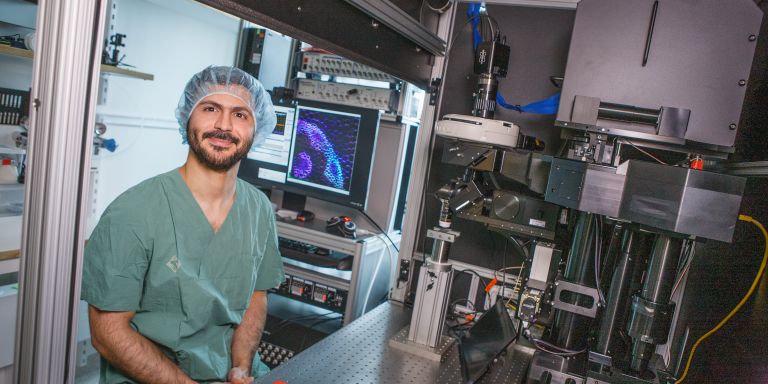
Stefanos Stagkourakis
PhD in Neuroscience
Wallenberg Academy Fellow 2023
Institution:
Karolinska Institutet
Research field:
Neurobiology, brain structures and the significance of neurons


Wallenberg Academy Fellow 2023
Institution:
Karolinska Institutet
Research field:
Neurobiology, brain structures and the significance of neurons
In fall 2024, a new state-of-the-art brain lab opened at SciLifeLab and Karolinska Institutet (KI) in Solna, just north of Stockholm. Here, Stagkourakis and his team study what happens in the brain when animals instinctively react to external events.
His aim is to uncover how the brain controls natural survival behaviors and to gain a deeper understanding of why certain experiences lead some individuals to exhibit extreme forms of aggression, fear, binge eating, sex addiction, or post-traumatic stress disorder. The researchers hope that clarifying these mechanisms will eventually pave the way for medications that can moderate such exaggerated responses.
Studying instincts is not easy: the brain areas that control our survival behaviors, such as the hypothalamus, are located deep within the brain and are difficult to access. It plays a central role in initiating physiological responses to emotional states like pleasure and anger.
“Our traditional view of the brain assumes distinct functions are carried out by specific neurons in specific regions. But how much can we really understand by only focusing on parts of the brain? We may be misled. We want to understand how the brain operates as a complex system,” says Stagkourakis.
The brain is organized into small anatomical units called nuclei, clusters of neurons that resemble islands, connected by intricate communication pathways.
The KI researchers are primarily focused on understanding how nerve cells or neuron networks and populations across the brain function.
Until recently, it was impossible to record what many call “the Holy Grail” in brain research: the activity of a sufficient number of individual neurons across large parts of the brain during behavior.
Stagkourakis explains:
“Only recently has it become possible to record the activity of large populations of single neurons across widespread brain regions of the mammalian brain.”
This breakthrough has been made possible through cutting-edge technologies that allow researchers to record electrical activity from large numbers of individual neurons simultaneously. During his time at the California Institute of Technology (2019–2024), Stagkourakis worked extensively with these tools like probes, an instrument that can measure Voltage, and brought this expertise with him to Sweden. As a Wallenberg Academy Fellow, he is now applying them in his lab at SciLifeLab.
Only recently has it become possible to record the activity of large populations of single neurons across widespread brain regions of the mammalian brain.
These probes directed towards mice use special sensor arrays to detect the tiny voltage changes that occur when neurons fire electrical signals known as action potentials. These signals can trigger the release of neurotransmitters such as norepinephrine, serotonin, and histamine, and are key to how the brain processes information.
In their experiments using mice, the KI researchers can monitor the activity of hundreds to thousands of neurons at once, even in deep brain structures. This enables them to map brain-wide neural dynamics with unprecedented resolution.
To understand which behaviors are linked to specific neurons, the researchers manipulate the activity of preselected neuron clusters during the expression of survival behaviors in mice. This is referred to as “perturbation” and is typically performed using optogenetics, gene modification which make cells light sensitive, or pharmaceuticals.
After eight months of experiments, Stagkourakis’ team early findings shed new light into the brain’s functional architecture. They are mapping the functional network architecture (based on single neuron activity) of the brain during physiological and excessive behavioral expressions.
“In the past, when we looked at neuron activity at specific sites of the brain and during specific behavioral contexts we found behavior-specific neuron populations, which we informally referred to as aggression neurons, mating neurons, and parental behavior neurons.”
The modern approach clearly illuminates a key property of single neurons, which was underappreciated. That is that individual neurons can be multifunctional – participating in multiple behaviors depending on context, a phenomenon known as mixed selectivity.
“The functional neural activity maps we aim to discover may be the smallest neural form of a behavioral expression,” says Stagkourakis.
Their working hypothesis is that activity across the brain is unlikely to be background noise. Neuron firing is metabolically expensive, and evolution placed constraints on the brain to operate in an energy-efficient manner,” Stagkourakis adds.
Stagkourakis is enthusiastic to have started his laboratory at SciLifeLab and Karolinska Institute, and hopes to strongly contribute to the institute’s history and ongoing efforts in generating world-class, impactful neuroscience.
“It has been so exciting to dive into this topic from day one and to set up experiments and to make cross-brain observations.”
Quote: “Only recently has it become possible to record the activity of large populations of single neurons across widespread brain regions of the mammalian brain.”
Text Monica Kleja
Translation Maxwell Arding
Photo Magnus Bergström